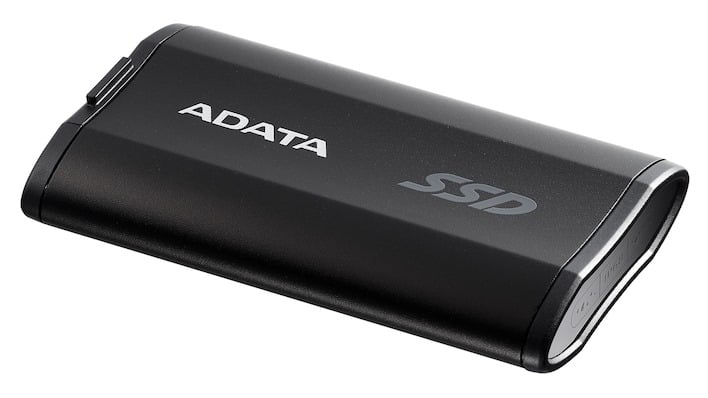The ADATA SD810 Portable SSD Is Tough And Tiny External Storage For Gamers & Creators
| ADATA SD810 SSD: Starting at $89.99 (1TB), up to $149.99 (2TB) The ADATA SD810 is a no-frills portable SSD with a tough titanium chassis, fast USB 20 Gbps connectivity, and IP68 ingress protection. |
|||

|

|
||
We’ve been making heavy use of the drive over the last couple of months, but don’t worry—we did our benchmarks before all that, with the drive in its fresh state. You can check out the basic specifications of the SD810 external SSD family in the table below. We’ll take a tour of the drive for a bit in some photos and then move on to the performance testing.
ADATA SD810 External SSD Specs & Features

The SD810 comes in the eye-catching magenta box above, but the majority of the box is empty space, even as small as it is. The box is smaller than a DVD case, and the SD810 is downright minuscule. Despite that, it still feels pretty weighty thanks to the all-metal chassis. ADATA says it’s titanium, and we have no reason to doubt that. It certainly feels sturdy in the hand.
The SD810 also comes in silver, and has understated aesthetics.
Using the SD810 couldn’t be simpler. It comes pre-formatted with exFAT, so all you have to do is pop the rubber endcap and plug in one of the included USB cables. That hard rubber endcap can be quite difficult to dislodge, especially on the first use, though; those with weak grips may want to enlist the help of a big dude, or maybe a silverback.
The tight endcap seal is probably necessary for the IP68 ingress protection rating. That describes the SSD’s ability to resist dust and water getting inside. ADATA clearly states that the IP68 rating only applies when the endcap is closed, which means you can’t take this thing underwater while using it. It’s still really nice in the event that you drop your SD810 in a puddle or something.
The SD810 is positively tiny; smaller than a credit card in footprint.
There’s not much else to say about the exterior of the SD810, although we do feel compelled to note that when under heavy use, such as when playing a game that’s installed on it, the SD810 gets very warm. It’s not alarmingly hot and won’t burn a hole in anything, but it would be very uncomfortable if you were, say, resting an arm or leg against it. So, don’t do that.
ADATA SD810 External SSD Performance
In order to test the performance of the ADATA SD810 Portable SSD, we enlisted the help of some benchmarks and real world tests. First up is ATTO, a disk benchmark that measures sequential transfer speeds across a specific volume length with various block sizes. It measures transfer rates for both reads and writes and graphs them out in an easily interpreted chart. ATTO’s workloads are sequential in nature and measure bandwidth, rather than I/O response time, access latency, etc.


The Silicon Motion controller inside the SD810 is potent, as you can see. The SD810 isn’t the fastest SSD in our comparison at every transfer size, but once you get out to the 32KB size, the SD810 breaks away from the competition and is consistently the speediest SSD in this group of external drives.
Next up are some numbers with SiSoft SANDRA, the the System ANalyzer, Diagnostic and Reporting Assistant. Here, we used the Physical Disk test suite and provide the results from our comparison SSDs…

Testing with SANDRA gives us phenomenal performance from the SD810, beating ADATA’s own “2000 MB/s MAX” label on the box—even if only just so. The write performance is excellent, too; we’ll talk more about that in a bit. Overall, the sequential performance of this SSD is around three times what you can achieve with a SATA SSD, which ain’t bad at all.
CrystalDiskMark is a synthetic benchmark that tests both sequential and random small and mid-sized file transfers using incompressible data. It provides a quick look at best and worst case scenarios with regard to SSD performance, best case being larger sequential transfers and worse case being small, random transfers.





This screenshot shows file copy performance on a 3.3GB file (the installer for UL’s PCMark 10 benchmark). We had to quickly snap the screenshot before the window vanished because the file copy of the 3.3GB archive was done in about 3 seconds. This is speedy storage.
That is, as long as you have the requisite USB 20Gbps connection and working UASP on your system. A Thunderbolt port will probably work too, in USB downward-compatibility mode. You can use the SD810 on any system with USB 2.0 or better, but getting these kinds of performance results is going to require a system that supports the correct connectivity. Even still, the SD810 will cap out any slower USB connection easily.
ADATA SD810 Portable SSD: The Verdict




